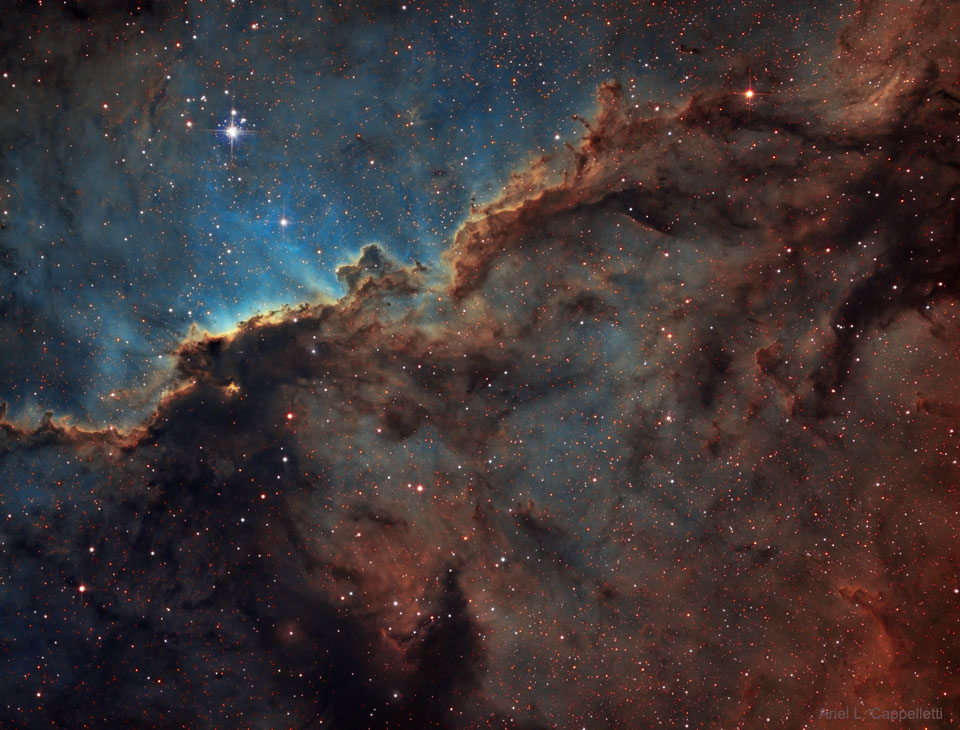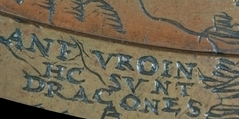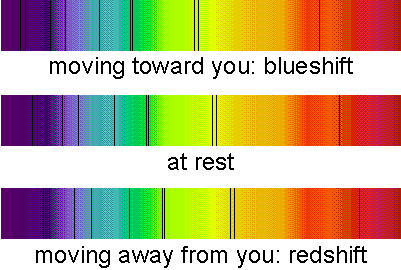johnnydeep wrote: ↑Tue Jul 28, 2020 6:34 pm
Why is it that everything is space is more interesting the more you learn about it? From the link to HD 150136 within the wikipedia article article about NGC 6139,
HD 150136 is listed in the Washington Double Star Catalog as having seven visual components within 30 arc seconds. Component A is a close triple system containing three massive class O main sequence stars. The brightest companion is catalogued individually as HD 150135 as well as component C of the multiple system, separated by only 10 arc-seconds. It is another O class spectroscopic binary and also a member of NGC 5193. The other stars are all 10th to 12th magnitude, similar to many other stars known to be members of NGC 6193.[6]
The primary star consists of a double-lined spectroscopic binary[4] with a more distant tertiary companion. The third star is orbiting the other two with a period of 8.2 years, an eccentricity of 0.73, and an inclination of 108°. The close binary stars are separated by hardly more than their own diameters and orbit in less than 3 days, but the third is separated enough to have been resolved visually by VLTI. The measured separation in 2012 was 9 milli arc seconds, corresponding to 11-12 AU.[5]
But I still don't quite understand this description. Does "seven visual components" mean at least that many stars? And one of those components (component A) is actually a triple star system? And HD 150135 is the brightest star of that triple? But then it says that HD 150135 is also called component C. Now is that of the triple or one of the seven visual components?
I'll answer some of your questions, but I can't promise that I will answer them all! Let's start with the double-lined spectroscopic binary. But to do that, we must first talk about spectral lines in general.
The light from all stars can be separated into colors, which will show the presence of spectral lines. The picture at right shows the full spectrum of the Sun.
The number, strength and position of the spectral lines depend on the star's temperature (hot or cool?), composition (many or few elements heavier than hydrogen and helium, and what heavier elements dominate?) and evolutionary status (a main sequence star, a large or huge giant star or a tiny white dwarf?). The number, strength and position of spectral lines are used by astronomers to characterize the stars that only look like points when they are photographed.
Our Sun is a star of spectral class G2V. The "G2" tells us that the temperature of the photosphere of the Sun is 5 778 K (or thereabout). The "V" means that the Sun is a main sequence star, which is to say that it is still fusing hydrogen to helium in its core.
To astronomers, spectral lines are like the star's fingerprints. Take a look at the Sun's spectrum at left. Can you see two lines at far left, in the blue-violet part of the spectrum? These are the K and H lines, caused by the presence of calcium. In a star with the temperature of the Sun, these lines will be prominent. Please note that these lines always form a doublet with a certain space between them.
If a star with the temperature of the Sun moves towards us, the K and H lines in its spectrum will be shifted to the blue. More precisely, in this particular case, a blueshift means that these particular lines will be found deeper in the violet part of the spectrum. A redshift, by contrast, means that the K and H lines will be shifted some distance towards the red, so that they will be less deep into the violet part of the spectrum.
Okay, now, so what is a spectroscopic binary?
Take a look at the picture at right. As I said, some spectral lines are always double, but some aren't. The picture at right shows the hydrogen alpha line (at 656.28 nm in the light from a white dwarf. Only the line is a double line. The hydrogen alpha line is never double in a single star. In this star, however, it is double.
The double Hα lines means that this white dwarf is actually a close binary, where the components are so close to one another that no present-day telescope can separate them. But each component produces its own set of spectral lines. As the stars orbit one another, unless we see them perfectly pole-on, their rotation will make one of them move towards us as the other one moves away from us. That way their spectral lines will be alternatively redshifted and blueshifted.
Let's look at the description of HD 150136 again:
HD 150136 is listed in the Washington Double Star Catalog as having seven visual components within 30 arc seconds. Component A is a close triple system containing three massive class O main sequence stars. The brightest companion is catalogued individually as HD 150135 as well as component C of the multiple system, separated by only 10 arc-seconds. It is another O class spectroscopic binary and also a member of NGC 5193. The other stars are all 10th to 12th magnitude, similar to many other stars known to be members of NGC 6193.[6]
The primary star consists of a double-lined spectroscopic binary[4] with a more distant tertiary companion. The third star is orbiting the other two with a period of 8.2 years, an eccentricity of 0.73, and an inclination of 108°. The close binary stars are separated by hardly more than their own diameters and orbit in less than 3 days, but the third is separated enough to have been resolved visually by VLTI. The measured separation in 2012 was 9 milli arc seconds, corresponding to 11-12 AU.
I agree with you that this is confusing. It's actually not very well written. Note that NGC 6193 is called "NGC 5193" in that quote.
Burt yes, seven visual components does mean at least that many stars.
Your question, is HD 150135 the brightest component of HD 150136, is a good one. Answer: No. I googled both using Simbad, and Simbad said that HD 150136 belongs to spectral class O3.5-O4III, whereas HD 150135 is a main sequence star of spectral class O6.5V. So HD 150136 is hotter, brighter and more evolved than HD 150135. HD 150136 is almost certainly more massive, too.
But HD 150136 and HD 150135 don't make up one spectroscopic binary. If they did, they wouldn't have two different HD numbers. They can be separated visually.
It would seem that
HD 150136 consists of three stars, two of which orbit one another so close that they form a spectroscopic binary, and the third component is- I think! -
HD 150135. So
HD 150135 is sort of a part of
HD 130136, even though
HD 150135 is a star all of its own at the same time...

NOOOO!!! Wait! I take that back!!!
HD 150136 and HD 150135 are different, separate stars, and one doesn't
belong to the other.
Consider the nearest star to our own, Alpha Centauri. This is either a double or a triple star system (I don't think astronomers are absolutely sure that tiny little Proxima is actually gravitationally bound to the bright pair. In any case, the two bright stars form a physical pair. The fainter component doesn't have an HD number as far as I can see, but it does have a Tycho and a Hipparcos number, and its Tycho and Hipparcos numbers are not the same as the Tycho and Hipparcos numbers of Alpha Centauri A.
Similarly, therefore, HD 150135 is a star that is separate from HD 150136, even though the two stars are most certainly physically bound. We need a collective name for HD 150136 and HD 150135 and all its components, don't you think so?
And I think the text that you quoted is telling us that
HD 150135 is itself also a spectroscopic binary.
Phew!
Ann
 NGC 6188: The Dragons of Ara
NGC 6188: The Dragons of Ara










